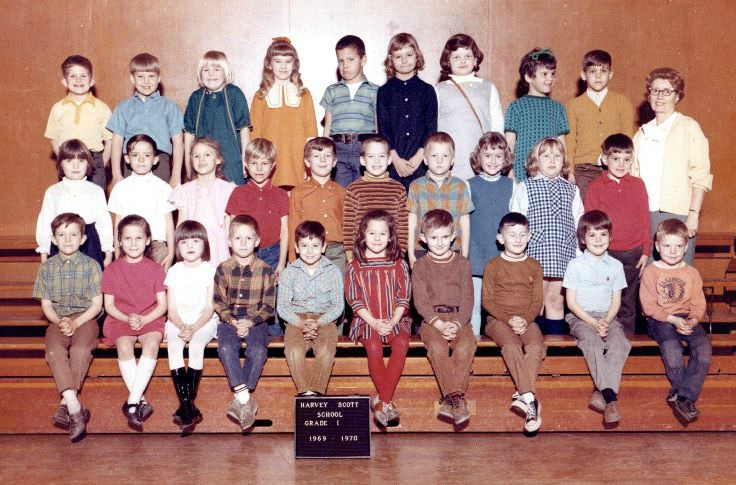Basically, we are all here to learn to share and pass the crayons and not eat the paste.

I can remember the name of every kid in my First Grade class, and tell at least one reasonably colorful story about each one of them, too.
For instance, the girl in the center of the front row wearing the red striped dress is Kay Whittington. Kay and I were pretty artsy, and when we were in second grade, we got to make a life-sized Abraham Lincoln by tracing around our very tall principal, Mr. McCray, while he lay on a long piece of butcher paper in the hallway.
See that first boy in the top row? The one in the yellow shirt? That’s Joe Albers. He wanted to be a fireman when he grew up. What’s amazing is, that is exactly what he ended up doing. I danced with Joe at our 8th grade graduation, to Stairway to Heaven. It’s a very long song, and I think it may have been a pity-dance for him, but for me, it was lovely.
Marilee is in the top row looking at our teacher instead of the camera. People used to get Marilee and me mixed up all the time, and I never understood why. She’s a teacher now, and still one of my dearest friends.
To name a few more, there’s Carl who I once took dance lessons with, and Tony who missed a lot of school due to health problems, and Jennifer who was always an entire head taller than me, and adorable William Lake, and David Rosenthal who was my first “boyfriend.” He’s the one in the front row with his eyes closed. We used to hold hands on the playground.
Me? I’m in the front row too: pink dress, black go-go boots (Oh, how I loved those go-go boots!), sitting between Lurissa Sponsler and Charles Tigard. Lurissa used to have long fingernails and was known to scratch boys on the playground with them. She’s a Special Ed teacher now. (Seems a lot of us are, come to think of it.) A few years back, she married another classmate of ours, Eric, and Rick and I get together with them every now and then for dinner.
Our teacher was sweet, red-headed Mrs. Sturgis, who seems much younger in this picture than I remember her. Back in the fall of ’69, we ran into her classroom every day excited about what life had to offer, all knee highs and go-go boots, pony tails and plaid shirts, just hoping our name would be on the chore chart next to “Feed the Fish.” Best job ever.
So here’s the thing… the reason they are all still so important to me: No one in Mrs. Sturgis’ class was a criminal, or out of work, or caught up in a moral scandal (at least not back then), but whenever a weather-beaten mug-shot or the image of a lost citizen flashes across my screen or darkens my news feed, I think of them.
Because while remembering all those kids is a good party trick, here’s my real Super Power: I can imagine anyone – Anyone – at six, sitting right there next to me with Joe and Lurissa and Marilee and all the rest. So for a split second, even the most heinous outlaw is – in my imagination – is all cotton socks, smooth skin and bright eyes. I mean, everyone was six once upon a time, right?
And then I wonder, what happened? How did that fresh faced kid in my mind’s eye become the slack-jawed delinquent on my screen?
Early in my career, I taught at a residential treatment facility for severely emotionally disturbed children, most of them victims of horrendous abuse. So I understand what exalts the ego or disfigures the soul from an educational, clinical, and psychiatric standpoint. Likewise, I recognize the sociological and environmental factors that influence behavior. But my question is more fundamental – why do some kids rise above whatever life throws at them, while others are crushed by it? How does a someone go from wanting to be a pilot or a baseball player or a train conductor to holding up 7-11’s? Conversely, what drives a young woman to leave a life of comfort to go and work at a Haitian orphanage?
Those faces in that old class picture are touchstones for me. Full of life and potential, they are constants that remind me we are all citizens of the planet and students in the world’s classroom, and basically, we are all here to learn to share and pass the crayons and not eat the paste. And when crime seems ubiquitous or tragedy strikes, it’s comforting – even humanizing – to remember that there was a time when everyone was a just kid in the first grade, waiting for his turn to feed the fish.
